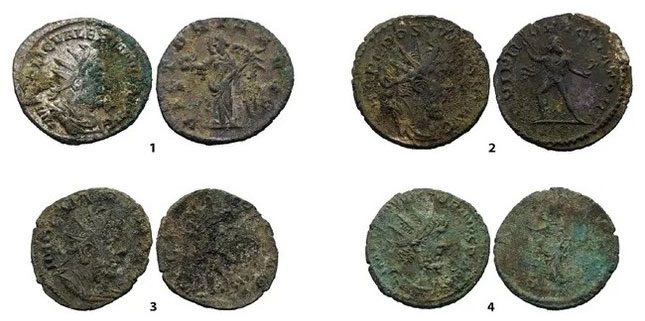A metal detectorist in Germany has discovered a rare treasure of nearly 3,000 Roman coins outside the ancient borders of the Roman Empire. Experts are unsure how or why this enormous treasure came to be there.
The detectorist promptly reported the findings to government archaeologists in Koblenz, a city on the Rhine River. The excavation subsequently uncovered approximately 2,940 coins as well as over 200 thin silver pieces adorned with geometric patterns, which were buried in a broken ceramic vessel hidden between two rocks.

Front and back of some Roman coins from the treasure found in Germany. (Photo: GDKE RLP, Landesarchäologie Koblenz).
Timo Lang, the director of the Koblenz branch of the State Archaeological Office in Rhineland-Palatinate, who supervised the excavation, stated: “Most of the coins are known as Antoniniani, which were the official silver coins of the Roman Empire during the 3rd century but were primarily made of bronze with a thin silver coating.”
Due to the poor condition of the coins, only about 100 have been identified so far, most depicting the portrait of a Roman or Gallic emperor on one side and other images on the reverse, such as the gods Hercules and Mars. The oldest coins depict Roman Emperor Gordianus III (who reigned from 238 to 244 AD), while the youngest coins feature Gallic Emperor Victorinus (who reigned from 269 to 271 AD). Archaeologists are unsure what the silver pieces were, but the shape of the ceramic vessel aligns with Roman pottery traditions from the 3rd century AD.
Timo Lang noted that these coins date from 241 to 243 AD to 269 to 271 AD, suggesting that this treasure may have been buried in the early 270s.
This discovery was made near the town of Herschbach in the Westerwald mountains, about 11 miles (18 km) from the Upper Germanic Limes, a defensive line marking the border of the Roman Empire with the Germanic tribes. While 3rd-century Roman coins are often found within the borders of the Empire, finding such a large treasure outside the former territory of the Empire is extremely rare.
So how did these coins end up in enemy territory? There are several possibilities. One is that the Gallic Empire may have attempted to bribe German elites to prevent them from attacking or invading the Roman Empire. However, why these coins were hidden in the Westerwald mountains, where no known German settlements exist, remains a mystery.


















































